![]()
![]()
![]()
Use LEFT and RIGHT arrow keys to navigate between flashcards;
Use UP and DOWN arrow keys to flip the card;
H to show hint;
A reads text to speech;
17 Cards in this Set
- Front
- Back
|
Basal Ganglia (BG) - overview |
- Input <- mostly from cerebral cortex - Output -> mostly back to CC (topographic) => modulate CC activity via intrinsic circuits & NT - dmg => disorders of movement, etc. - striatum = caudate, putamen - globus pallidus = external & internal segment - substantia nigra = pars reticulata & compacta - subthalamic nucleus |
|
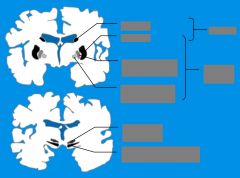
|
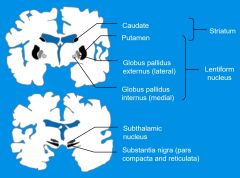
|
|
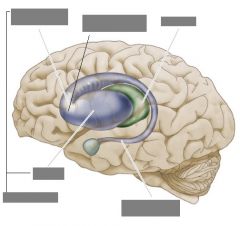
|
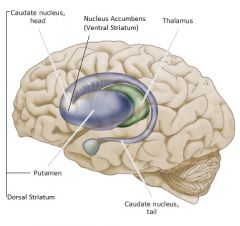
|
|
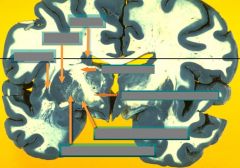
|
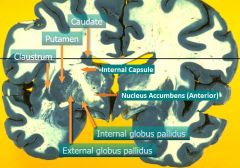
|
|
|
Input/output in Basal Ganglia |
Input/output - Caudate/Putamen: <- all CC areas (exc. 1° auditory & visual C) <- Substantia Nigra-pars compacta [dopamine] -> SN-pars reticulata -> Globus Pallidus ->> - external: subthalamic nucleus -> internal GP: - internal: thalamus (VA/VL) -> CC (premotor) |
|
|
Extrapyramidal system feedback loop |
CC -> (+) Caudate & Putamen <-> SN-pars compacta -> (-) GP & SN-pars reticulata <-> subthalamic nu. --> (-) Superior colliculus --> (-) Thalamus -> (+) CC - direct pwy -> movement - indirect pwy --| movement |
|
|
Direct pwy in BG |
CC -> Striatum (medium spiny n.'s), direct pwy --| Globus Pallidus-internal (tonically active) --| Thalamus (VA/VL) -> Frontal Cortex [dysinhibitory circuit] & SN-pars compacta (D1, transient) -> Striatum |
|
|
Indirect pwy in BG |
= Direct pwy + - SN-pars compacta (D2, transient) --| Striatum, indirect pathway [thus overall exc.] --| GP-external -> ----| GP-internal ----| Subthalamic nucleus -> GP-internal [- both inhibitory] |
|
|
Motor vs. Oculomotor loop |
[Parietal C, Cerebellum, BG? ->] Motor/premotor/somatosensory C -> Putamen --| GPi --| VL/VA Thalamus -> CC Posterior parietal/prefrontal C -> Caudate --| GPi --| MD, VA Thalamus -> CC --| SN-PR --| Superior Colliculus -> Eye mm. |
|
|
Connectivity w/in projections to BG |
- convergence (CC -> Striatum -> GP) - fxnal considerations: focusing - intrinsic circuitry - center-surround inhibition |
|
|
Striatum: intrinsic circuitry |
- medium spiny n.'s - cholinergic IN's - enkephalinergic IN's - projection n.'s -> GABA ~ "patchwork" of NT's |
|
|
Ventral striatal system |
- control of emotional posture & tone: Limbic Cortex -> Ventral Striatum (N.Accumbens) --| Ventral Pallidum --| MD Thalamus -> LC VTA (D3, D4) -> Ventral Striatum [↑ in Schizophrenia] ~ mesolimbic DA reward sys. |
|
|
Parkinson's disease - clinical signs |
Dx (2/3): - bradykinesia - rigidity - tremor (primarily at rest) Onset: insidious; unilateral -> bilateral Other signs: masked face, hypovolemic speech, swallowing difficulty, micrographia, flexed posture, shuffling gait, hesitancy & freezing |
|
|
PD: Pathology |
- degeneration of SN-pars compacta (DA -> Striatum) => ↓ direct pwy, ↑ indirect pwy => ↓ fb VA/VL Thalamus -> CC |
|
|
PD: Treatment |
Levodopa: DA -> striatum (D1, D2) Amantadine: STN, GPe --| indirect pwy Neurosurgery: - Pallidotomy --| GPi - DBS --| STN, GPi Gene therapy - STN: Glu -> (GAD) -> GABA |
|
|
Huntington's Disease |
- linked to gene IT15 on Ch 4p - symptoms: -- chorea -- quick/jerky/random involuntary movements - can be caused by Striatal degeneration (HD) or excess DA |
|
|
Hyperkinesias associated w/ HD |
Athetosis: slow writing, snakelike movements (<- many lesions, esp. of Striatum) Hemiballism: flailing limb movements (<- subthalamic nucleus lesions) Dystonia: twisting of the limbs, trunk, neck (<- structural/fxnal abnormality of basal ganglia) |

